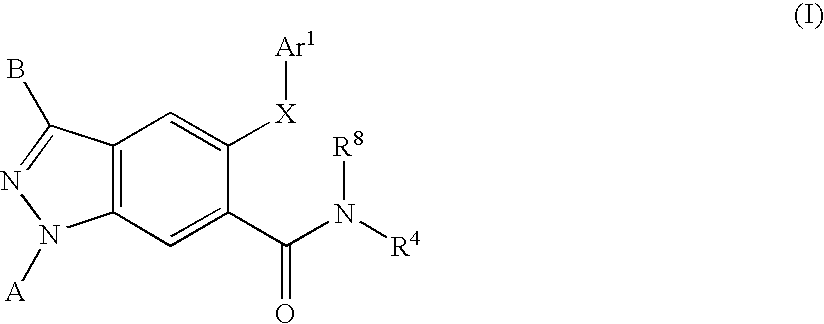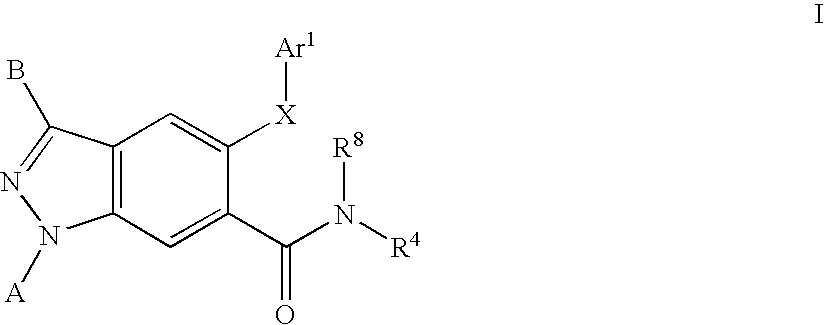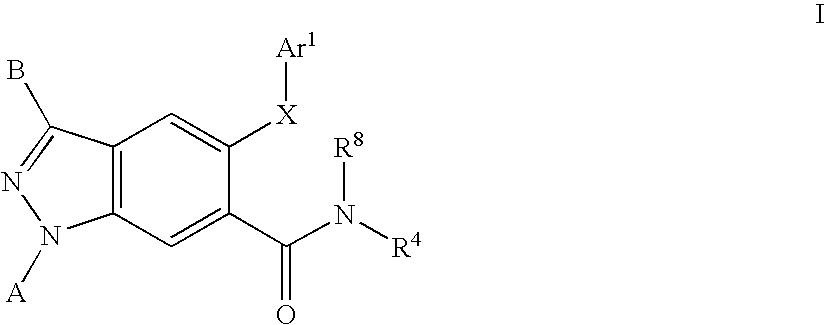P38 inhibitors and methods of use thereof
- Summary
- Abstract
- Description
- Claims
- Application Information
AI Technical Summary
Benefits of technology
Problems solved by technology
Method used
Image
Examples
example a
p38 Biochemical Assay
[0227]P38 activity was assayed at room temperature in a 100 μL reaction containing 5 nM activated p38α enzyme and 1 μM ATF-2 (Activating Transcription Factor 2 fusion protein) as the substrate in 25 mM HEPES (pH 7.4), 100 μM Vanadate, 1 mM DTT, 10 mM MgCl2 and 10 μM [γ-33P]-ATP (˜0.1 μCi P33 / reaction). The reaction was terminated after 30-40 minutes by adding 25% TCA, allowed to stand for 5 minutes and then transferred directly to a GF-B membrane filter plate. The filter was washed twice for 30 seconds with 0.5% phosphoric acid using a Tomtec Mach III Automated Harvestor. After washing, the vacuum was continued for 30 seconds to dry the filter. Approximately 30 μL of scintillant was added per well to the filter plate and then read in a Liquid Scintillation Counter (Packard TopCount HTS). All compounds exemplified herein had an EC50 as determined by this assay of 10 μM or less.
example b
Human Whole Blood TNF-α Assay
[0228]Compound test solutions were made by making 3.33 fold serial dilutions in DMSO, which dilutions were then diluted to 5× stocks by diluting with MEM, 2% heat inactivated fetal bovine serum (“FBS”), 20 mM HEPES, 2 mM L-glutamine, and 1% penicillin / streptomycin.
[0229]Whole blood was collected from human volunteers using sodium heparin Vacutainer™ tubes and processed within two hours of collection. Blood was diluted 3-fold with Whole Blood (WB) medium (RPMI 1640, 2% heat inactivated fetal bovine serum, 20 mM HEPES, 2 mM L-glutamine, and 1% penicillin / streptomycin). 100 μL of diluted blood was added to each well of a 96-well cell culture plate, followed by 30 μL of a compound test solution.
[0230]After a one-hour incubation at 37° C. / 5% CO2, 20 μL of 7.5 ng / mL lipopolysaccharide (E. coli K-235, Sigma L2018) was added to each well. The cells were incubated again at 37° C. / 5% CO2 for 16-20 hours. The test compound supernatants were collected and assayed fo...
example 1
General Procedure for the Synthesis of Lactam Intermediates (4)
[0236]The general synthesis of lactam intermediates (4) suitable for use in the preparation of compounds of Formula I is shown in Scheme 2. An appropriated amino acid (3) (22.6 mmol) is added to a stirring solution of hexamethyldisilazide (46 mL, 9.8 mmol) in acetonitrile (95 mL) in a round bottom flask equipped with a reflux condenser under an atmosphere of dry nitrogen. The reaction is heated to reflux for 2 days, and then allowed to cool to ambient temperature. The crude reaction mixture is poured onto ice-cold methanol, and allowed to warm to ambient temperature. The reaction mixture is concentrated and diluted with chloroform. The suspension is filtered, and the filtrated is concentrated to yield the lactam intermediate (4).
PUM
| Property | Measurement | Unit |
|---|---|---|
| Pharmaceutically acceptable | aaaaa | aaaaa |
Abstract
Description
Claims
Application Information
 Login to View More
Login to View More - R&D
- Intellectual Property
- Life Sciences
- Materials
- Tech Scout
- Unparalleled Data Quality
- Higher Quality Content
- 60% Fewer Hallucinations
Browse by: Latest US Patents, China's latest patents, Technical Efficacy Thesaurus, Application Domain, Technology Topic, Popular Technical Reports.
© 2025 PatSnap. All rights reserved.Legal|Privacy policy|Modern Slavery Act Transparency Statement|Sitemap|About US| Contact US: help@patsnap.com



